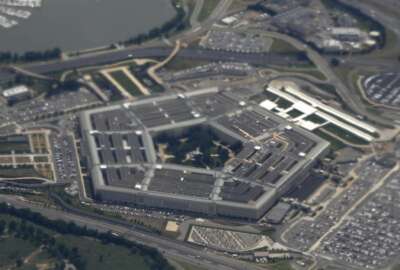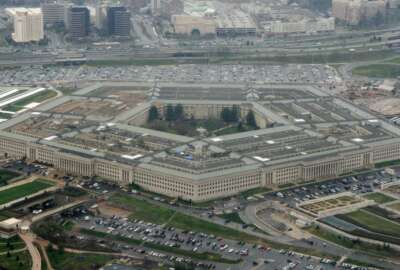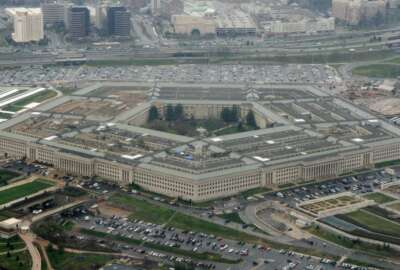Pentagon faces political battle to retire old weapons systems — and some newer ones
The Navy and Air Force want to shed existing weapons systems to free up funds for great power competition. Many of those systems really are old, but not all.
Best listening experience is on Chrome, Firefox or Safari. Subscribe to Federal Drive’s daily audio interviews on Apple Podcasts or PodcastOne.
Both the Air Force and the Navy want Congress’s permission to retire some of their weapons platforms, generally with the rationale that the money saved by doing so will let them reallocate funds toward the sort of high-end warfare the Pentagon believes it needs to prepare for.
Some of those systems are decades-old, and are understandably showing their age. But not all of them.
The most glaring examples of expensive systems slated for retirement, even though they have plenty of useful service life remaining, are the four littoral combat ships the Navy is proposing to dispose of. Each is less than a decade old, and the newest of them, the USS Little Rock, was commissioned less than four years ago. Its first operational deployment was last year.
But getting the ship into a condition where it would be useful and survivable in the kinds of real-world combat operations DoD is planning for — where it might face highly-capable military adversaries — would require expensive upgrades that aren’t the best use of Navy funding at the moment, considering pressure on its topline budget, said Vice Adm. James Kilby, the deputy chief of naval operations for warfighting requirements and capabilities.
So when it came to deciding whether to keep or ditch the Little Rock, a vessel the Navy just spent several hundred million dollars to build, the decision mostly came down to stopping avoidable costs, he said.
“We really look at key operational problems against the adversary — particularly China — and their advances, and we look at our program and balance it against it. We have a model-based systems engineering approach to look at those investments that we think will either accelerate or match the adversary. There’s a de-emphasis on strongly-held opinion, and an emphasis on analysis and wargaming,” he told the Senate Appropriations Committee this week. “It’s not that the things we’re talking about divesting are not valuable — they are valuable. They’re just less valuable than the things we need to invest in to have a capable force.”
But in many other cases, the systems the services are seeking to divest are simply getting old.
Officials argue that not only are they less likely to perform adequately in a high-end battle than newer systems, but their age means they need more maintenance, and the military’s repair facilities and personnel are already stretched very thinly.
The Navy’s guided missile cruisers are among its oldest platforms, with an average age of 32 years. The service is proposing to retire two more cruisers next year; it’s previously asked Congress to retire five others.
The Navy estimates keeping just those two aging hulls, the USS Anzio and the USS Hue City, as a credible part of the battle force would cost $1.5 billion in maintenance and upgrades.
“It would be very difficult to come up with a construct where we’d be able to bring them out [of maintenance] and make them relevant in the time we’d need,” Kilby said.
In terms of average age, the Navy’s overall fleet of ships and aircraft is just 14 years old. Its sister service, the Air Force, is ancient by comparison.
The average airframe in that service is 29 years old, and 44 percent of Air Force pilots are flying planes that are already past their planned design life, said Lt. Gen. David Nahom, the deputy chief of staff for plans and programs.
Nahom said the service desperately needs to rid itself of older aircraft — like the earlier B and C generations of the F-15 fighter — to make more space in its operating budget for newer variants, like the F-15EX.
“I’m very familiar with the F-15C — it’s the platform where I spent most of my time in the Air Force, and it’s falling apart,” he said. “There’s a number of them sitting at Warner Robins Air Force Base right now with cracks, just looking for ways to ways those aircraft … We’ve got to get new aircraft to these units who are flying so far beyond their initial design service life so they can safely operate and defend our nation.”
Lawmakers urged to purge aging fleet
Like the Navy’s request to divest some of its ships, Nahom said the Air Force’s request is certainly driven — at least in part — by topline budget constraints.
But he urged lawmakers to resist the temptation to keep older aircraft in the inventory simply by adding more money to this year’s budget request and prohibiting divestitures.
That’s because each service has only so much capacity in its maintenance depots, and the difficulties involved with keeping an aging fleet in an airworthy condition have already caused the Air Force’s maintenance costs to rise by 130% in the last 20 years. Significant delays on deliveries of new platforms, like the F-35 fighter and the KC-46 tanker, have contributed to that problem.
“The same incredible men and women who are swinging wrenches and flying A-10s and F-16s today are the the same incredible men and women I need flying F-35s tomorrow,” he said. “As we continue to take the F-35 through the assembly line, we’ve got to divest [older aircraft], otherwise we run into a huge manpower problem. The question of money is interesting and very important, but the people piece is actually where I think we’ll have the most difficulty when you talk about additional resources.”
It’s too early to tell how much Congressional opposition the services will face toward their divestment requests.
In their testimony before the Senate Appropriations Committee this week, Navy and Air Force officials didn’t face significant pushback — though Sen. John Tester noted that parochial interests were likely to make some of them a tough sell once a DoD spending bill reaches the Senate floor.
“There is not a member on this committee that doesn’t get pressure from other members that serve in the Senate to keep some of these systems,” said Tester (D-Mont.), the chairman of the defense appropriations subcommittee.
In its version of the annual Defense authorization bill, the Senate Armed Services Committee is attempting to block at least some of DoD’s proposed divestitures.
According to a summary of the bill the committee released Thursday, that chamber’s initial draft of the National Defense Authorization Act (NDAA) would prohibit the Air Force from retiring at least some of the KC-135 tankers and A-10 aircraft it has proposed to divest.
The summary also describes some restrictions on Navy divestments; the precise details haven’t been disclosed. The Senate committee develops its bill behind closed doors, and the full text of its version of the NDAA had not been published as of Thursday.
The House Armed Services Committee is expected to mark up its version of the bill next week. Unlike its Senate counterpart, as usual, the House will conduct the process in open session.
Copyright © 2025 Federal News Network. All rights reserved. This website is not intended for users located within the European Economic Area.
Jared Serbu is deputy editor of Federal News Network and reports on the Defense Department’s contracting, legislative, workforce and IT issues.
Follow @jserbuWFED







